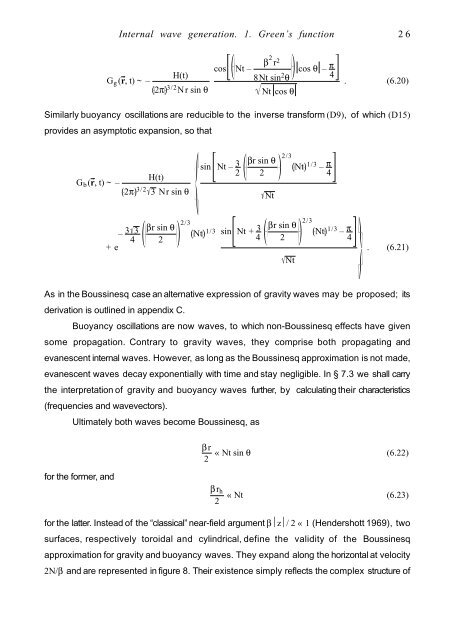Internal Wave Generation in Uniformly Stratified Fluids. 1 ... - LEGI
Internal Wave Generation in Uniformly Stratified Fluids. 1 ... - LEGI
Internal Wave Generation in Uniformly Stratified Fluids. 1 ... - LEGI
Create successful ePaper yourself
Turn your PDF publications into a flip-book with our unique Google optimized e-Paper software.
H(t)<br />
Gg (r, t) ~ –<br />
2π 3/2Nr s<strong>in</strong> θ<br />
cos Nt – β2 r 2<br />
8Nt s<strong>in</strong> 2 θ cos θ – π 4<br />
Nt cos θ<br />
. (6.20)<br />
Similarly buoyancy oscillations are reducible to the <strong>in</strong>verse transform (D9), of which (D15)<br />
provides an asymptotic expansion, so that<br />
Gb(r, t) ~ –<br />
– 3 3<br />
4<br />
+ e<br />
H(t)<br />
2π 3/2 3 Nr s<strong>in</strong> θ<br />
βr s<strong>in</strong> θ<br />
2<br />
2/3<br />
Nt 1/3<br />
s<strong>in</strong> Nt – 3<br />
2<br />
βr s<strong>in</strong> θ<br />
2<br />
s<strong>in</strong> Nt + 3<br />
4<br />
Nt<br />
2/3<br />
βr s<strong>in</strong> θ<br />
2<br />
Nt<br />
Nt 1/3 – π<br />
4<br />
2/3<br />
Nt 1/3 – π 4<br />
. (6.21)<br />
As <strong>in</strong> the Bouss<strong>in</strong>esq case an alternative expression of gravity waves may be proposed; its<br />
derivation is outl<strong>in</strong>ed <strong>in</strong> appendix C.<br />
Buoyancy oscillations are now waves, to which non-Bouss<strong>in</strong>esq effects have given<br />
some propagation. Contrary to gravity waves, they comprise both propagat<strong>in</strong>g and<br />
evanescent <strong>in</strong>ternal waves. However, as long as the Bouss<strong>in</strong>esq approximation is not made,<br />
evanescent waves decay exponentially with time and stay negligible. In § 7.3 we shall carry<br />
the <strong>in</strong>terpretation of gravity and buoyancy waves further, by calculat<strong>in</strong>g their characteristics<br />
(frequencies and wavevectors).<br />
Ultimately both waves become Bouss<strong>in</strong>esq, as<br />
for the former, and<br />
<strong>Internal</strong> wave generation. 1. Green’s function 26<br />
βr<br />
2<br />
« Nt s<strong>in</strong> θ (6.22)<br />
βrh<br />
2<br />
« Nt (6.23)<br />
for the latter. Instead of the “classical” near-field argument β⏐z⏐/ 2 « 1 (Hendershott 1969), two<br />
surfaces, respectively toroidal and cyl<strong>in</strong>drical, def<strong>in</strong>e the validity of the Bouss<strong>in</strong>esq<br />
approximation for gravity and buoyancy waves. They expand along the horizontal at velocity<br />
2N/β and are represented <strong>in</strong> figure 8. Their existence simply reflects the complex structure of


